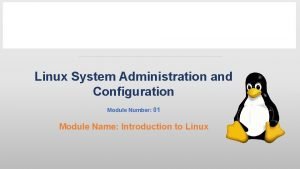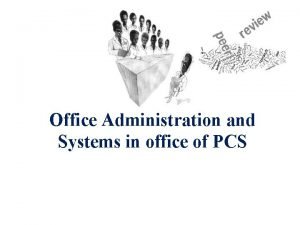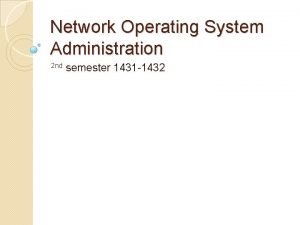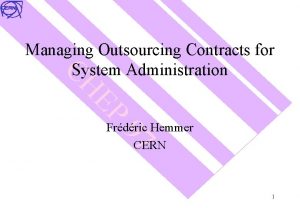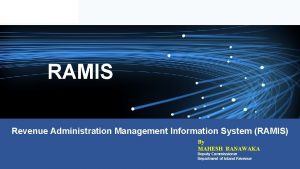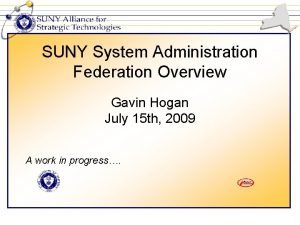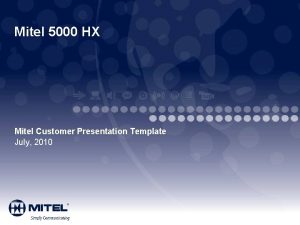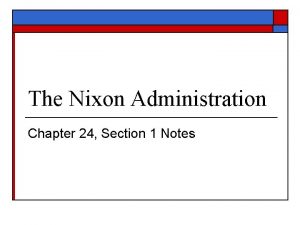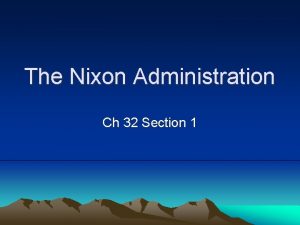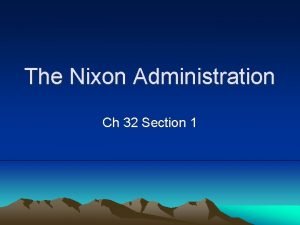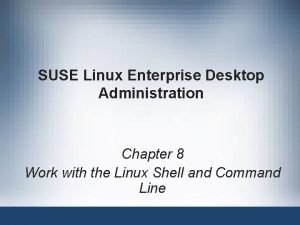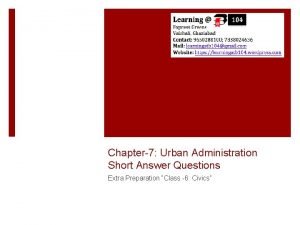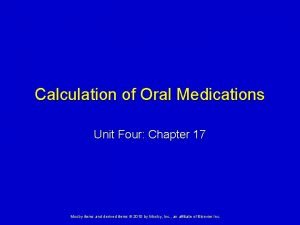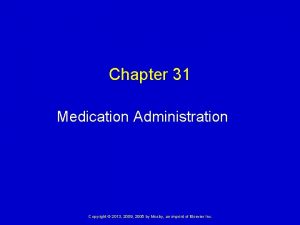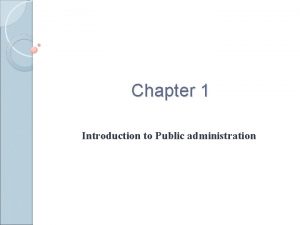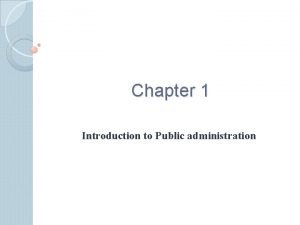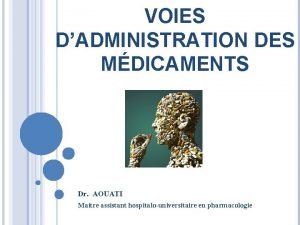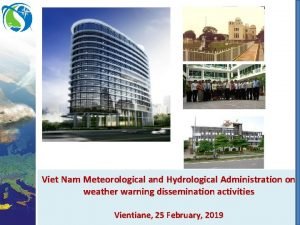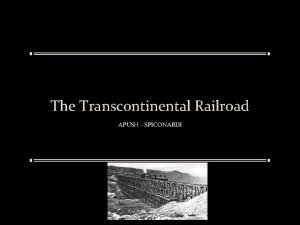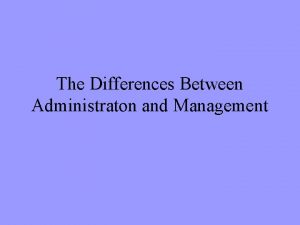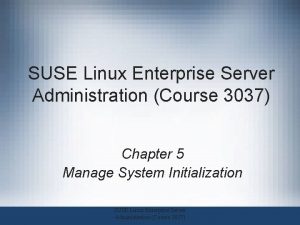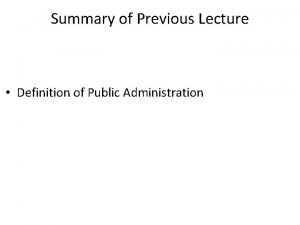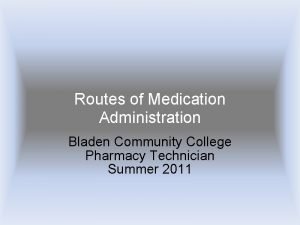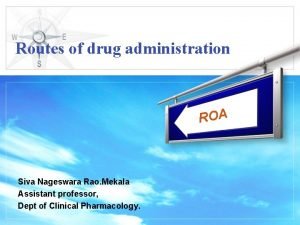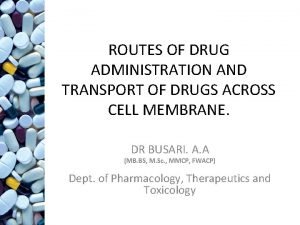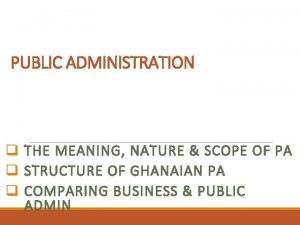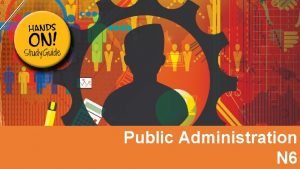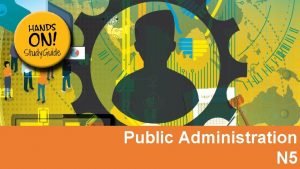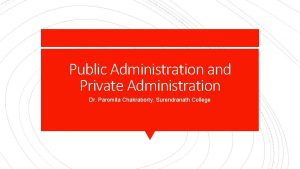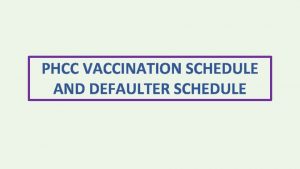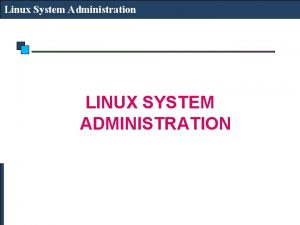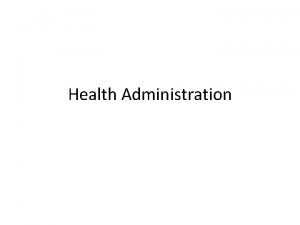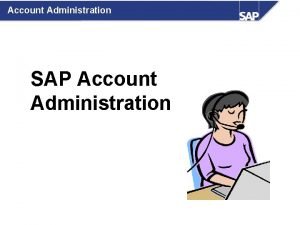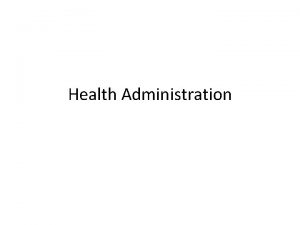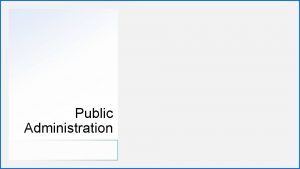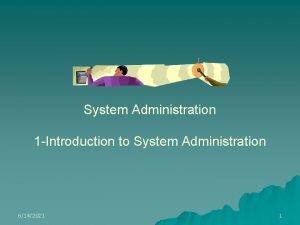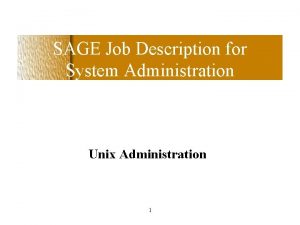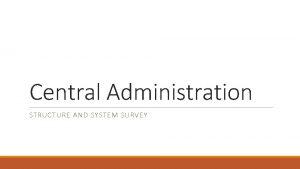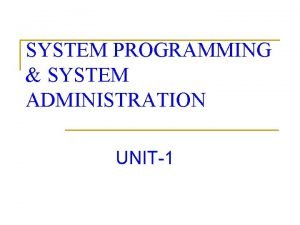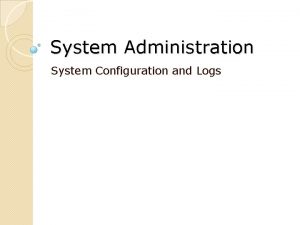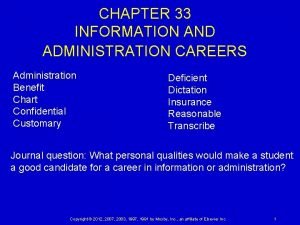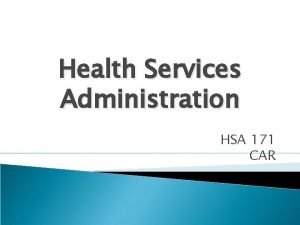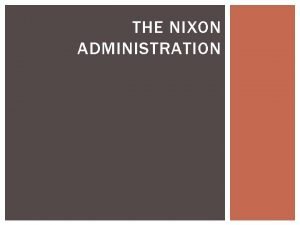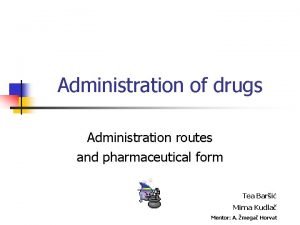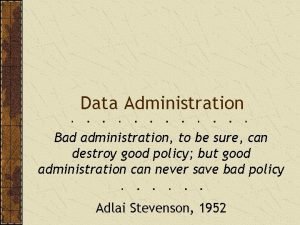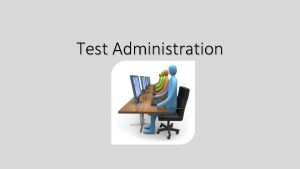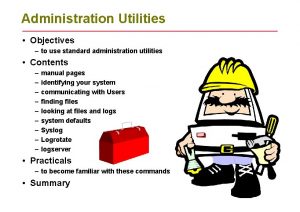Chapter 14 System Administration Chapter 14 System Administration








































- Slides: 40

Chapter 14 System Administration

Chapter 14 System Administration Chapter Outline System Administration Focus - A Standard Hardware Platform? The Acquisition Process Determining Requirements and Evaluating Performance Focus - Windows XP and Server Performance Monitoring Security Physical Environment

Chapter Goals Describe system administration responsibilities and tasks Explain the process of acquiring computer hardware and system software Describe tools and processes for evaluating application resource requirements and computer system performance Define a system security model and describe how it can be implemented Understand issues related to installing and protecting computer hardware

Chapter Topics

System Administration • Primary responsibility – Ensure efficient and reliable delivery of IS services • Broad categories of tasks – Acquiring new IS resources – Maintaining existing IS resources – Designing and implementing an IS security policy • Varies among organizations

Strategic Planning • Goal-Plan Paradigm – Set long-range goals – Develop a plan to attain those goals • Tends to follow rather than lead strategic plans of other organizational units – IS serves business needs

Strategic Goals and Plans • Goals – Identify services to be provided and the resources needed to provide those services • Plan – Strategies for developing services and markets for them – Strategies for acquiring sufficient resources for operations and growth – Organizational structure and control

Hardware and Software as Infrastructure • Strategic issues relevant to IS – Services to be provided – Charging for services – Infrastructure composition – Infrastructure improvement and maintenance

Standards • Required when providing infrastructure-based services to a wide variety of users • Potential issues – – Tends to stifle innovation May fail to meet needs of some users Incompatibility Problems for users who need services at or near the leading edge of technology

Competitive Advantage • Technology can be applied to: – Provide services that competitors are unable to provide – Provide services of unusually high quality – Provide services at unusually low price – Generate services at unusually low cost • Restricted useful life due to: – Rapid technology changes – High cost for developers and early adopters

The Acquisition Process • Determine applications that will be supported • Specify hardware and software capability and capacity requirements • Draft and circulate a request for proposals (RFP) • Evaluate RFP responses • Negotiate purchase, installation, and/or maintenance contract

Request for Proposals (RFP) • Formal document sent to vendors • States requirements • Solicits proposals to meet requirements

Evaluating Proposals • Determine acceptability of each proposal • Rank acceptable proposals • Validate high-ranking proposals – Benchmarking

Determining Requirements and Evaluating Performance • Hardware requirements depend on hardware and system software resources required • Is application software going to be developed? – Yes: hardware and system software resource consumption can be measured – No: determining resource requirements is complex • use benchmark testing

Determining Requirements and Evaluating Performance • Mathematical models for estimating computer requirements – Application demand model – Resource availability model

Benchmarks • Measure of computer system performance while executing specific processing tasks • Organizations that develop widely used benchmarks and perform computer system testing – SPEC (Standard Performance Evaluation Corporation) – TPC (Transaction Processing Performance Council)

Measuring Resource Demand Utilization • Hardware and software monitors – Detect and report processing or I/O activity – Operate continuously or intermittently – Help identify performance bottlenecks • Program profilers – Describe resource or service utilization of an application program during execution

Windows XP and Server Performance Monitoring • System Monitor (SM) – Monitors hardware and software resource use in real time – Captures performance and utilization data for defined objects • Each object has a set of counters – Has many display options

Security • Well-integrated approach protects hardware, software, and data resources against accidental loss or damage, malicious tampering, unauthorized access, and accidental disclosure • First line of defense: – Authentication and authorization • Other defensive measures: – Password control – Auditing – Virus protection – Regular software updates – Firewalls

Physical Security • Restrict access to prevent theft, tampering, and unauthorized access – Lock doors – Limit distribution of keys, key cards, etc. – Reinforce doors and walls – Lock equipment to desks

Access Controls • Based on two key processes – Authentication (verifies identity) • Password-based most common • Biometric – Authorization (verifies rights) • Based on security tickets • Access control list

Password Controls and Security • Ways to enhance password-based authentication – Restrictions on length and composition of valid passwords – Requirements that passwords periodically be changed – Analysis of password content to identify passwords that are easily guessed – Encryption of passwords in files and during transmission over a network

Auditing • Process of creating and managing records of user activity or resource access • Useful tool for examining security policy and analyzing security breaches

Limitations of Auditing • Size of logs – Auditing log files can grow very large • Reduction in system performance – Auditing uses lots of system resources • Poor tool for prevention – Auditing is backward-looking • Difficult to use – Automated search tools required to extract useful information

Viruses • Programs or program fragments that: – Infect computer by permanently installing themselves in a hard-to-find location – Perform malicious acts on infected computer – Replicate and spread using services of infected computer • Types: boot virus, macro virus, worm

Virus Protection • Common features of antivirus software – Scans e-mail messages and attachments for known viruses; disables or deletes them – Monitors access to important system files and data structures and logs or denies access as appropriate – Scans removable media for known viruses when they are inserted – Periodically scans file system and important data structures for viruses

Software Updates • Fix bugs, errors, and security holes as they are discovered • Used to be a manual process; now typically automated

Firewalls • Hardware devices, software, or a combination that prevents unauthorized users in one network from accessing resources on another network • A firewall is typically a stand-alone device with embedded software that physically separates a private network from a public network.

Firewalls A firewall is typically a stand-alone device with embedded software that physically separates a private network from a public network.

Types of Firewalls Packetfiltering firewall Stateful firewalls Application firewall • Simplest type • Examines each packet; matches header content to a list of allowed or denied packet types • Tracks progress of complex clientserver interactions • Handles service requests of external users of applications • Shields internal servers and resources from direct access by outside users

Application Firewall

Physical Environment • Considerations when choosing or preparing a location for computer hardware – Electrical power – Heat dissipation – Moisture – Cable routing – Fire protection

Electrical Power • Fluctuations can cause momentary loss of operation or damage to electrical circuits • Types of fluctuations – Momentary power surges • surge protector – Momentary power sags – Long-term voltage sags – Total loss of power • auxiliary power source, such as USP

Heat Dissipation • Excessive heat can cause intermittent or total failure of electrical circuits • Means of heat dissipation – Vents or fans on the computer itself – Cooling the room – Auxiliary cooling of cabinet

Moisture • Excessive moisture – Danger of short circuits • Low humidity – Buildup of static electricity • Protective measures – Well-designed cabinets protect against spills and leaks – Mount hardware above floor level – Control humidity with optional components of heating, ventilation, and air conditioning systems

Cable Routing • Provide protection and ease of access with: – Raised floors – Dedicated cable conduits

Fire Protection • Protection – Carbon dioxide – Fire retardant foams and powders – Gaseous compounds • Supplemental detection equipment within computer room

Disaster Planning and Recovery • Periodic data backup and storage of backups at alternate sites • Backup and storage of critical software at alternate sites • Installing duplicate or supplementary equipment at alternate sites • Arrangements for leasing existing equipment at alternate sites

Summary • System administration • The acquisition process • Determining requirements • Evaluating performance • Security • Physical environment

Chapter Goals Describe system administration responsibilities and tasks Explain the process of acquiring computer hardware and system software Describe tools and processes for evaluating application resource requirements and computer system performance Define a system security model and describe how it can be implemented Understand issues related to installing and protecting computer hardware
 Revenue administration management information system
Revenue administration management information system System administration module
System administration module Placement administration and support system
Placement administration and support system Office administration system
Office administration system Network operating system administration
Network operating system administration System administration outsourcing
System administration outsourcing Ramis system
Ramis system Gavin hogan
Gavin hogan Mitel 5000 hx
Mitel 5000 hx Chapter 24 section 1: the nixon administration answers
Chapter 24 section 1: the nixon administration answers Chapter 32 section 1 the nixon administration
Chapter 32 section 1 the nixon administration Chapter 32 section 1 the nixon administration
Chapter 32 section 1 the nixon administration Linux operation and administration chapter 8
Linux operation and administration chapter 8 Chapter 24 section 1 the nixon administration
Chapter 24 section 1 the nixon administration Chapter 7 urban administration question answer
Chapter 7 urban administration question answer Chapter 17 dosage calculation and medication administration
Chapter 17 dosage calculation and medication administration Chapter 31 medication administration
Chapter 31 medication administration Public administration chapter 1
Public administration chapter 1 Public administration chapter 1
Public administration chapter 1 Maryland insurance administration
Maryland insurance administration Explain differential piece wage system with example
Explain differential piece wage system with example Voie d'administration sans effraction
Voie d'administration sans effraction Vietnam meteorological and hydrological administration
Vietnam meteorological and hydrological administration Railroad administration apush
Railroad administration apush National academy for public administration
National academy for public administration Draw a person test administration
Draw a person test administration Difference between administration and management
Difference between administration and management Suse linux administration
Suse linux administration Personnel administration
Personnel administration Route of administration of lozenges
Route of administration of lozenges Roa drug
Roa drug Route of drug administration definition
Route of drug administration definition State geodetic administration
State geodetic administration Scope of public administration
Scope of public administration Generic administrative functions
Generic administrative functions Public administration n5 module 1
Public administration n5 module 1 Public and private administration
Public and private administration Difference between administration and management
Difference between administration and management Student-related reliability
Student-related reliability Defaulter vaccination schedule
Defaulter vaccination schedule 1 inch
1 inch

